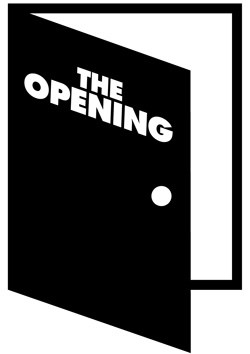
|
THE OPENING is all about introducing the fascinating, quirky and wonderful people working in and around the visual arts in Vancouver. Each week, we'll feature an artist, collective, curator or administrator to delve deep into who and what makes art happen! |
Vancouver artist Raymond Boisjoly combines an invested interest in text-based works with a black metal aesthetic. A graduate of Emily Carr's Fine Art's degree program and UBC's Master's program, Raymond's work is featured in Or Gallery's Studies in Decay, a group show with Jordy Hamilton and Laura Piasta, curated by Jonah Gray. Raymond is currently a sessional instructor at Emily Carr.
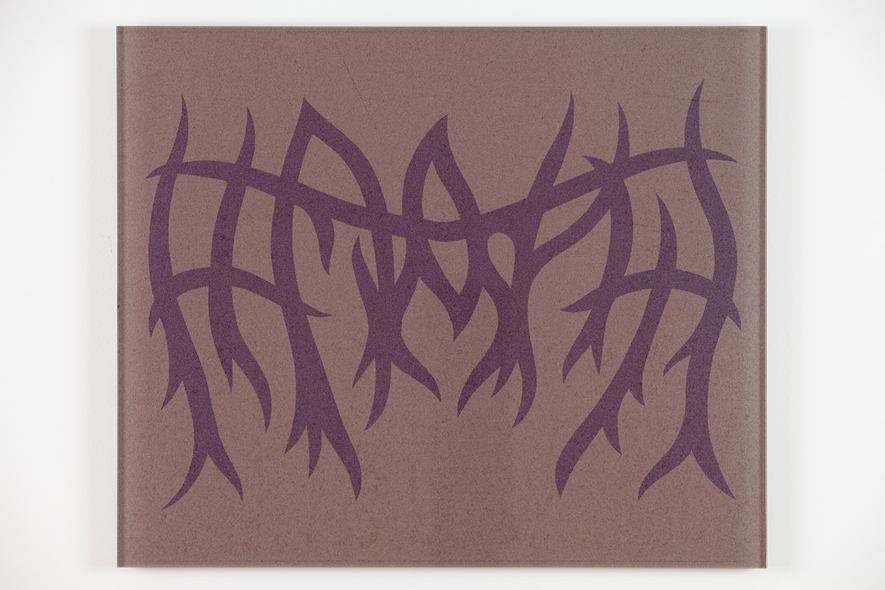
'The Writing Lesson' series (2011) sunlight, construction paper, Plexiglas (photo: Blaine Campbell, Republic Gallery)
Congratulations on the Or show. How did it all begin?
It came about through discussions with a friend of mine, Jonah Gray, who’s in the CCST Program at UBC. He had certain interests, like the ability for art to refer to social reality—art that isn’t self-contained, that is somehow a response to some sort of phenomenon ‘out there.’ He was interested in particular works, and we had talked about this body of work I was making.
Your piece is alongside the work of Jordy Hamilton and Laura Piasta, and all three bodies work really well together.
Yeah, it’s definitely a funny group of works. I really like Jordy’s project. It’s totally absurd, just kind of insane. I like the colour of Jordy’s photographs, those vintage consumer colour prints, what age has done to them. They’re yellowed, all of the colours are slightly muted, and the way that the surface has been affected as well, those spots of discolouration. Totally something that I can appreciate.
You’ve got this beautiful object in the crystallized denim jacket, and then a bike getting shot up. Both of these are alongside a text which references a black metal aesthetic. The entire show contains a very youthful and almost angry impression...
Yeah. Or it somehow seems almost vital. As if there’s something kind of active within them.
So much of your work seems to have this contradiction of enchantment and disappointment, positivity and negativity. This is something that you’re always working through?
It’s nothing that I’m pursuing consciously. A lot of it just happens in the process of making the work. This sort of thing, I guess, is just always there. It’s something I usually only recognize in retrospect. Especially with a lot of the more recent text works, where it’s trying to pursue some kind of complicated idea, but then there’s a certain sentiment borne out in it that I don’t know if I did pursue consciously. It’s a very strange feeling. I try to understand my encounter with it, which is hopefully not so different from how other people encounter it: this object that is kind of difficult to absorb, that has some bearing on my understanding of the world, and that doesn’t confirm or deny any sort of idea. It is a generative object to try and think through.
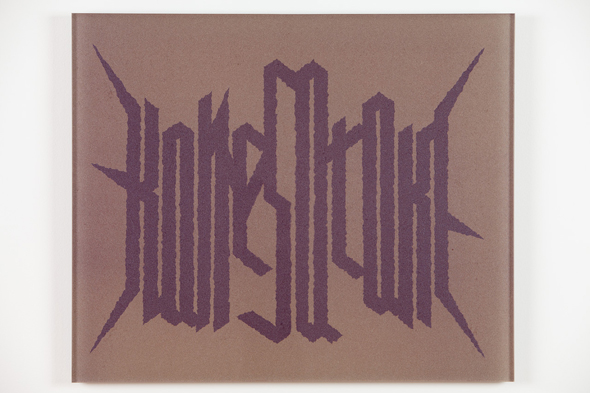
'The Writing Lesson' series (2011) sunlight, construction paper, Plexiglas (photo: Blaine Campbell, Republic Gallery)
'Spuzzum' is very abstracted. To look at it, there is so much meaning in the form alone, and then in the actual content of the word. This is something that emerges in a lot of your text-based work.
The work exists so that you have to look through the tarp to see the text. The tarp is the most immediate visual phenomenon. There’s text behind it, but the tarp is in front of it. For the work that I just recently showed at Republic, The Writing Lesson, I used trans mounting, mounting an image to a piece of plexi. The plexi necessarily becomes a part of the image. The use of a tarp makes a similar relationship, a necessity of looking through materials to see what the work actually is. They’re not strictly identical, but somehow analogous to each other. In once sense it’s fairly easy to look through the plexi to see the image, but the work at the Or becomes very hard, to see how the tarp changes the text behind it. It isn’t about trying to present them in a neutral manner, but seeing how the material can be productive in certain visual relationships.
I have this interest in text-based works, and the material carrier of text. Text often functions transparently. We don’t necessarily think about how a book operates when we’re reading. [The work] is an attempt to find a way for the text to communicate something of its own character. A lot of it becomes a matter of thinking through vernacular forms, like vernacular approaches to the organization of text.
The imagery is derived from black metal, which has an interesting cultural context. Black metal is perhaps known most popularly for a series of murders and church burnings in the early 1990s. The church burnings were a long-delayed revenge for the displacement of pre-Christian spiritual sites in Northern Europe. So it’s treated like a reproduction of a certain violence that has been enacted upon pre-Christians in Northern Europe. What I was trying to do was posit that as somewhat analogous to colonial assimilation practices in Canada. It seemed like a productive analogy but also a difficult one. Just the idea that there are these dudes who are asking themselves these serious deep questions through a form derived from heavy metal seemed like a cultural outlet that’s important. What they did was fairly extreme, but I can appreciate the sentiment or attitude. They’re making explicit comments on the limits put on life in the contemporary world. It’s definitely pretty fascinating.
With The Writing Lesson, it’s fun finding a way to show how any given material can be mobilized in the construction of works. The associations that they bring are important. That process of exposing construction paper is like a rudimentary photo process. It’s a bit silly or absurd, but somehow also shows the flexibility of these things. To pursue these things consciously changes the inflection of the materials, and somehow there’s something beyond the mere content of the work. It becomes a kind of material investigation. I find those sorts of formal questions fun.
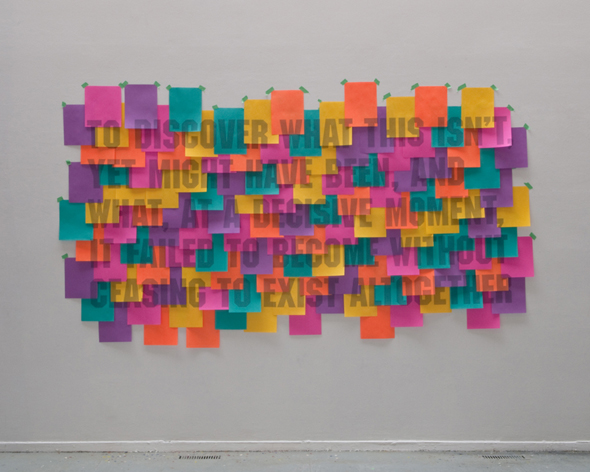
Makeshift and Makeshift I (2010)
You took a childhood material and immediately invested it with a weighty photographic history. It’s a very heavy-handed act, but also a simple gesture.
The novelty for me is being able to list sunlight in the list of materials. It’s sunlight on construction paper, and I try to imagine it as not only the action of the sunlight on the paper itself but also the notion that it somehow contains it, or becomes a means to grasp this seemingly immaterial thing.
You are invested in an educational system as an artist and were recently involved in the Seattle show at Hedreen Gallery, where a big focus was the question of how one educates an artistic practice, and where the line is drawn between education and art practice. Where are you standing on that issue right now?
I think it’s important to foreground the educational aspects of art institutions. It’s a matter of seeing the ways that people relate to the world, or the ways to frame that experience, and how things can complicate the seemingly transparent relationship of someone to their world. It’s a matter of making some aspect of it tangible, [opening] it up for analysis or study. The education system is definitely important. It is important for a lot of art galleries associated with educational institutions, like Hedreen in Seattle. They just seem fairly flexible. They have a more realistic or practical understanding of the fact that art can do something—it doesn’t have to, but it can.
How far do you think you’re going to invest yourself as a teacher of art? I’m interested in the concept of teaching art, the conflict and also the potential of teaching, and the place where it puts the artist who is suddenly teaching: the sacrifice you make to your own practice, and also the concurrent potential genesis that your practice may get from it. Are you finding it hard to negotiate being in a system that’s so time-consuming?
Teaching is really great. It demands that I find a way to communicate my enthusiasm. I can see students’ enthusiasm for ideas. I find it very fulfilling. I don’t really see it as a constraint, but definitely demanding. It teaches me to find some way to frame my own interests through avenues I don’t necessarily pursue. It is a pretty manageable way to still be involved with art without it necessarily being specifically about my practice. I find it really stimulating to try and work through certain ideas, and try to provide a wider range of practices for students to discuss. You facilitate a wider discussion amongst people who are extending themselves as art students, who are potentially coming around to understanding themselves as artists.
The Symptom of the Universe pieces. I’ve never seen them in person, and I’m curious as to their forms.
The Symptom of the Universe pieces are a collage work. They’re images from the Hubble telescope. There was a point where I was trying to think through certain scientific images, through the seeming capacity for photographic images to be treated neutrally—the idea that there was a neutral contrast, that there was the suggestion that there was an appropriate way to print the photographic images that makes it fully communicable. So those works were a look at this imagery that was derived from a scientific apparatus. It was an attempt to give it a more cultural inflection, of trying to relate it to Northwest Coast form line. It was a funny project. My research at the time was looking at African American musical traditions as reflected or transformed within the music of Parliament Funkadelic, which came out of an African American experience, but [was transposed] on a cosmic field. I was trying to work through what I saw as the resonance of Parliament Funkadelic, find some way to respond to it visually, and find some way to relate it to my own experience and to how tradition is necessarily transformed.
I’ve moved beyond it, in a sense of the relationship of aboriginal peoples to tradition. I see the constant attempts to implicate tradition in the works that contemporary aboriginal artists do. I think it’s difficult. I’m still trying to work through it, and I try to avoid contextualizing my work in terms of tradition in the sense that I don’t want to give any perverted sense of what my personal practice is. I’m trying to attribute to it a distinct character, as being someone who doesn’t take part in ceremonial life, and who hasn’t pursued traditional forms.
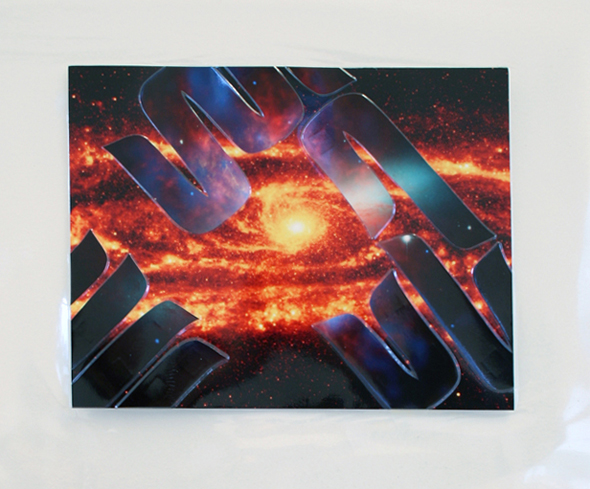
The Symptom of the Universe
In that meeting of your own personal associations with your culture and traditional practices, is there a conflict there, or is it play?
Definitely a struggle. At a certain point it’s fine, but at a certain point the connotation is that people might draw a certain understanding of tradition from a work of contemporary aboriginal art that isn’t strictly traditional. People can mistake it for the thing it seemingly refers to. I’m anxious to communicate that what it is that I do is solely my responsibility, that it doesn’t reflect any sort of specific cultural background. I’m almost anxious to find some way of communicating the complexity of aboriginal experience without producing material which people might simply take as an extension of tradition, going back to time immemorial. It’s hard to articulate: wanting to produce works which are in the contemporary world, and show that they are derived from an aboriginal perspective but that the most immediate realm in which they operate is not traditional.
I see a number of artists who are able to do that, who are able to distinguish what it is that they do from conventional understandings of aboriginal cultural practice. The immediate artist that comes to mind is Marianne Nicholson, making paintings derived from the dimensions of button blankets. It’s not the thing itself, it’s something different, something transformed. In being transposed into the context of contemporary art, it requires some transformation so people don’t mistake it for the thing it references. That process of misrecognition is too easy, too comfortable. It requires some kind of openness, that the relationship to tradition is spacious and should be necessarily open to contestation.
I’m interested in the process through which some people find authority through traditional practices, and see that as an important process so long as it doesn’t restrict people’s ability to participate. aboriginal peoples in the contemporary world and their understandings of their indigenous spiritual traditions, it’s a very weird thing. It’s something I’m trying to think through. To make work that provides opportunities to think through these things, to have the idea that there’s no necessary way to discuss the issues facing aboriginal peoples. They’re so varied and diverse. Anything that can illuminate certain ideas and issues is workable. I guess it’s about also knowing that there’s a contingent aspect to it: that there’s no appropriate means to discuss these things. It’s a matter of being realistic about what any given work does. It’s not a matter of exaggerating the implements of any particular work, but knowing that a work is good and appropriate within the immediate circumstances it responds to. That is to me what makes a good art practice exciting.
I'm curious to see how your perspective would direct the Contemporary Aboriginal Arts class you're teaching at Emily Carr.
I usually work from certain concepts or ideas or theories. I’m trying to think through those approaches to analyze certain practices and see what the implications of those ideas are when directed towards aboriginal practices. It’s an exciting course that’s allowed me to devote a lot of time to trying find some way that I can communicate my enthusiasm for the intellectual aspects of contemporary art through the work of aboriginal artists. It’s a fun process. It can be a stressful process as well in the sense that I’m not working from conventional approaches.
For a lot of students it’s the first non-required course they are taking, so that commitment is borne out in their discussion. It definitely does get a little sensitive but it feels like our discussions are productive. For a lot of the works I tend to discuss I stress the political or social or cultural aspects of the work. The things that people are dealing with in artwork and critical writing about aboriginal art are important for anyone. It’s been interesting to find ways to discuss it without discussing it, or finding what artworks do, what artworks accomplish and how they can simply be a means to discuss issues facing aboriginal peoples specifically. I find it’s given me something to test my own capacity to articulate my interests.
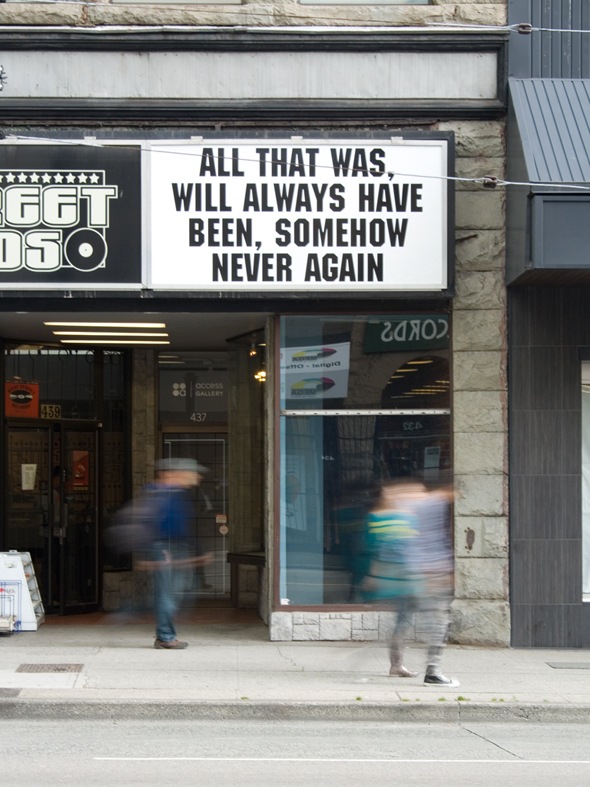
All that was, will always have been, somehow never again (2010)
The texts that you made that are so perfectly ambiguous. Do you have any desire to do a longer or larger text piece? How far do you want to take this?
Well those ones are difficult. They can be so ambiguous that it’s difficult to say what they’re actually doing. The continued use of text throughout the works I’ve done can be strange. I don’t want to be limited by how I’ve been able to imagine my practice thus far. I’m open to something unforeseen, to being transformed by something else. I try to imagine that as an entirely necessary thing to do. Some other way of doing it is likely to make itself apparent, The necessity of pursuing that pushes me to be attentive, to be open to things. It’s important to me to not think that I know what it is that I’m doing.
I’m interested in those practices which are ultimately project-based, which have the capacity to respond to the world. I find it stimulating. Finding some common or vernacular material and knowing that it communicates outside the realm of art, that art is simply one practice amongst others. It works, there’s something significant about it, but it’s not necessarily more significant than other things. It’s something I’ve been interested in working through: the fact that art is singular but not exemplary. It’s simply one thing amongst others, one means of engaging with the world, of producing ideas about the world. But there is an infinite amount of other ways to do so.
I think your piece for Access accomplished that. It’s not a confined or contained work. Anyone walking down the street would be exposed to it, would be free to engage with it.
It was the first exhibition at Access at which that sign was conceived for and produced for, but the fact that it outlasts that particular Access space [they have now moved to 222 E Georgia St] is funny. It’s interesting to think of how the life of that text changes. The associations it comes to contain and respond to is funny, but interesting in a sense that it’s not me that still exercises significance on it. It’s responsive to its context. It’s about how it participates in the world.
It’s interesting seeing older works and being surprised. The process of writing a work like that, having it come sort of easily, and then trying to do it again. It gets a little frustrating. It’s interesting trying to think through the process, of trying to do it again and seeing how it can change.
You have an upcoming show...
It’s a show at Forest City Gallery in London, Ontario. There will be an iteration of Makeshift and Makeshift I. It’s going to change somewhat, I’m not exactly sure how. It’s an attempt to think through it again, to try to make it do something else, to add to it. It’s had a second iteration in Seattle. It was similarly convoluted and absurd.
————–
Raymond Boisjoly will be taking part in a lecture series organized by Imminent Future at Vivo Media Arts Centre on November 5th at 2:00pm. Raymond, Harjap Grewal, Tone Olaf Nielsen, and Glen Coulthard will discuss their current projects and work relating to global migration, aboriginal language, and alternative education. Visit Imminent Future's Facebook event page for more details. Raymond Boisjoly, Jordy Hamilton, Laura Piasta: Studies in Decay is on at Or Gallery until December 10th.
All photos courtesy Raymond Boisjoly unless otherwise noted.


